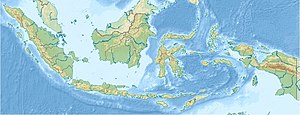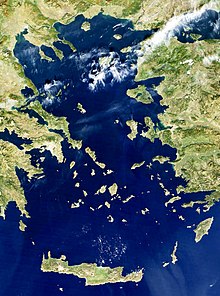Anarchipelago(/ˌɑːrkəˈpɛləɡoʊ/AR-kə-PEL-ə-goh),[1]sometimes called anisland grouporisland chain,is a chain, cluster, or collection ofislands,or sometimes a sea containing a small number of scattered islands.



Examples of archipelagos include: theIndonesian Archipelago,theAleutian Islands,theLakshadweepIslands, theGalápagos Islands,theJapanese archipelago,thePhilippine Archipelago,theMaldives,theBalearic Islands,theÅland Islands,The Bahamas,theAegean Islands,theHawaiian Islands,theCanary Islands,Malta,theAzores,theCanadian Arctic Archipelago,theBritish Isles,the islands of theArchipelago Sea,andShetland.Archipelagos are sometimes defined by political boundaries. For example, while they are geopolitically divided, theSan Juan IslandsandGulf Islandsgeologically form part of a larger Gulf Archipelago.[2]
Etymology
editThe wordarchipelagois derived from theAncient Greekἄρχι-(arkhi-,"chief" ) and πέλαγος (pélagos,"sea" ) through the Italianarcipelago.Inantiquity,"Archipelago" (fromMedieval Greek*ἀρχιπέλαγος andLatinarchipelagus) was the proper name for theAegean Sea.Later, usage shifted to refer to theAegean Islands(since the sea has a large number of islands).
Geographic types
editArchipelagos may be found isolated in large amounts of water or neighbouring a large land mass. For example,Scotlandhas more than 700 islands surrounding its mainland, which form an archipelago.
Archipelagos are often volcanic, forming alongisland arcsgenerated bysubductionzones orhotspots,but may also be the result oferosion,deposition,andland elevation.Depending on their geological origin, islands forming archipelagos can be referred to asoceanic islands,continental fragments,orcontinental islands.[3]
Oceanic islands
editOceanic islands are mainly of volcanic origin, and widely separated from any adjacent continent. TheHawaiian IslandsandGalapagos Islandsin thePacific,andMascarene Islandsin the southIndian Oceanare examples.
Continental fragments
editContinental fragments correspond to land masses that have separated from a continental mass due totectonicdisplacement. TheFarallon Islandsoff the coast ofCaliforniaare an example.
Continental archipelagos
editSets of islands formed close to the coast of a continent are considered continental archipelagos when they form part of the same continental shelf, when those islands are above-water extensions of the shelf. The islands of theInside Passageoff the coast ofBritish Columbiaand theCanadian Arctic Archipelagoare examples.
Artificial archipelagos
editArtificial archipelagos have been created in various countries for different purposes.Palm IslandsandThe World Islandsoff Dubai were or are being created for leisure and tourism purposes.[4][5]Marker Waddenin the Netherlands is being built as a conservation area for birds and other wildlife.[6]
Superlatives
editThe largest archipelago in the world by number of islands is theArchipelago Sea,which is part ofFinland.There are approximately 40,000, mostly uninhabited, islands[7]
The largest archipelagic state in the world by area, and by population, isIndonesia.[8]
See also
editReferences
edit- ^"archipelago".Dictionary.com Unabridged(Online). n.d.
- ^NOAA."What is an archipelago?".National Ocean Service.Retrieved10 May2023.
- ^Whittaker R. J. & Fernández-Palacios J. M. (2007)Island Biogeography: Ecology, Evolution, and Conservation.New York, Oxford University Press
- ^McFadden, Christopher (22 December 2019)."7+ Amazing Facts About Dubai's Palm Islands".Interesting Engineering.Retrieved8 July2020.
- ^Wainwright, Oliver (13 February 2018)."Not the end of The World: the return of Dubai's ultimate folly".The Guardian.Retrieved8 July2020.
- ^Boffey, Daniel (27 April 2019)."Marker Wadden, the manmade Dutch archipelago where wild birds reign supreme".The Guardian.Retrieved8 July2020.
- ^"Nautical chart: International no. 1205, SE61, Baltic Sea, North, Sea of Åland"(PDF).Archived fromthe original(PDF)on 20 October 2017.Retrieved16 March2023.
- ^"Indonesia".The World Factbook(2024 ed.).Central Intelligence Agency.Retrieved7 December2008.(Archived 2008 edition.)
External links
edit- Chisholm, Hugh,ed. (1911)..Encyclopædia Britannica(11th ed.). Cambridge University Press.
- 30 Most Incredible Island Archipelagos